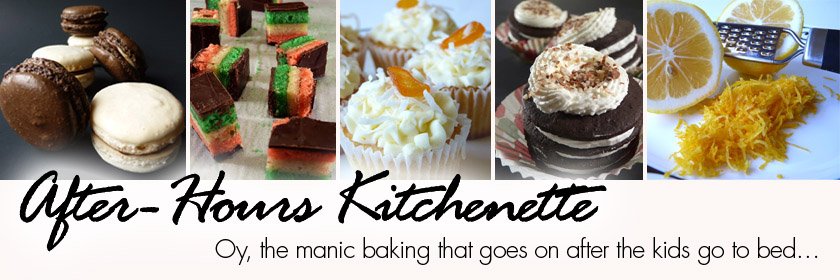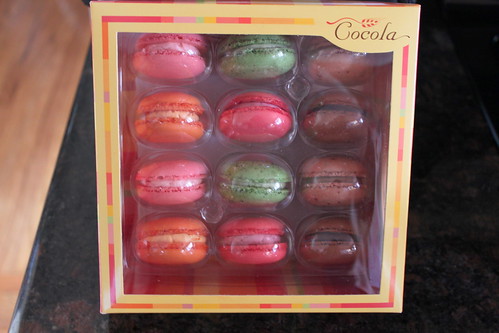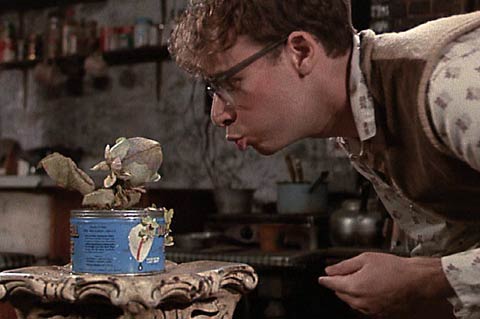
One of the projects we made in 8th grade home ec class was cream puffs. The only other project I remember making in the cooking portion of our home ec class was apple pie. The apple pie I still make -- using a recipe pretty darned close to that first 8th-grade recipe, but the cream puffs... not so much.
The sewing portion of home ec is a whole 'nother story, involving a blouse that fell apart the first time I wore it and a little embroidered bird that fared a bit better, and the beginnings of an aversion to sewing altogether. Luckily for me, years later I would discover the joy (and frugality) of making my own fancy pillows and window treatments and shower curtains, and were it not for the demise of my sewing machine a few years ago, this might have been a blog about creating funky home fashions on a budget.
Back to the cream puffs. I didn't care for them. I still don't. I'm not a big fan of pate a choux dough-based pastries, which includes cream puffs, eclairs, crullers.
But my recent research and forays into spun sugar-land also brought up lots of info on croquembouche: cream puffs dipped in a caramel glaze, arranged into a tall, skinny pyramid and wrapped in an ethereal cloud of spun sugar. The challenge stuck in my craw, despite my dislike of cream puffs. I mean... dipped in caramel? Anything tastes better dipped in caramel.
Easter dinner at the folks' was coming up, and I volunteered to make dessert, so I wanted to make something more original than carrot cake (which I do love, btw). I know croquembouches are more associated with Christmas than any other holiday, but what the hell, right?
My favorite cookbook in all the world is Sherry Yard's "Secrets of Baking":

The awe-inspiring recipes herein and the helpful and vast know-how that Yard imparts will one day spawn my year-long "Julia and Julia"-type adventure, where I bake every single recipe in the book, in order, much to my family's chagrin.
Yard's croquembouche recipe breaks down the project into three smaller, more manageable projects, each of which I tackled on three different days. First up, the pate a choux:
------------------------------------------------
Pate a Choux
(from "The Secrets of Baking" by Sherry Yard)
1 cup bread flour
1 tsp sugar
1/4 tsp salt
1/2 cup water
1/2 cup whole milk
6 tbsp butter
4-5 large eggs
For the egg wash:
1 egg plus 1 yolk
Sift together the flour, sugar, and salt in a large bowl. Set aside.
Bring the water, milk, and butter to a boil in a large saucepan over medium heat. Once it boils, remove the pan from the heat and add the flour mixture all at once. Using a wooden spoon, stir vigorously to combine.
Return the mixture to medium heat and stir constantly in figure eights. Cook for at least 4 minutes, or until the mixture has a smooth, mashed-potato-like appearance. This helps to break down the starch and develop the gluten. Remove from heat.
Transfer the hot mixture to the bowl of a standing mixer fitted with a paddle attachment or use a hand mixer. Mix on low for 1 to 2 minutes. Add 4 eggs, one at a time. Be sure to let the batter absorb each egg and scrape down the sides of the bowl with a rubber spatula before adding the next. Before adding the last egg, test for consistency. Pinch off about 1 tsp of the dough with your thumb and index finger, then pull your fingers apart. The dough should stretch rather than break. If it breaks, add the last egg. Mix on low speed until thoroughly incorporated, about 2 minutes. Do the finger test for consistency again. The dough should be shiny and smooth.
For cream puffs: Fit a large plain tip into a large piping bag. Make a big cuff at the top of the bag and fill the bag halfway with choux paste. Uncuff and twist the top of the bag to push the contents toward the tip. Pipe mounds 1 1/2 inches in diameter and 1 inch high.
Preheat the oven to 425 F. Adjust the rack to the center of the oven and place a heatproof baking dish or pan on the floor of the oven.
Line a baking sheet with a Silpat.
Make the egg wash by whisking the egg and yolk in a small bowl. Brush lightly but evenly over the piped dough.
Place the baking sheet in the oven and pour hot water into the baking dish on the oven floor. Quickly close the door to keep all the steam in the oven. Bake for 10 minutes, or until the puffs begin to rise, then turn the heat down to 350 F and rotate the baking sheet. Prop the oven door open slightly with a wooden spoon and bake for about 15 more minutes, until the pastries turn nutty brown.
Remove from the oven and cool completely on a rack.
------------------------------------------------
So I did this all the first night, two days before Easter, and packed them carefully in freezer bags and set them in the freezer. Easy and pretty, and the one puff that offered itself up for a taste test reminded me that yes, indeed, pate a choux is not my favorite. Still that bland, slightly leathery vehicle for gooey pastry cream delivery.



Next up: pastry cream. This part wasn't quite as easy or as pretty as the puffs. For one, Yard's book, as excellent as it is, contains a grievous error at a critical point, and B) I not only stumbled at that critical point, but also at enough critical points along the way that I wound up with the dreaded "grainy pastry cream."
------------------------------------------------
Chocolate Pastry Cream
(from "The Secrets of Baking" by Sherry Yard)
yield: 2 to 2 1/4 cups
2 cups milk
1/2 cup sugar
1 1/2 t finely chopped orange zest (I forewent the zest for this variation)
2 t vanilla extract
3 T all-purpose flour or cornstarch
pinch of salt
5 large egg yolks or 3 large eggs, chilled
1 T unsalted butter, softened
4 oz. bittersweet chocolate
If you will need to cool this quickly, line a baking sheet with plastic film and set aside.
Bring the milk, 1/4 cup sugar, and vanilla to a simmer in a medium nonreactive saucepan over medium heat
Meanwhile, sift together the remaining 1/4 cup sugar, the flour or cornstarch, and salt onto a piece orf parchment paper. Whisk the egg yolks or eggs in a large bowl. Add the sifted dry ingredients and whisk until fluffy.
When the milk comes to a simmer, remove from the heat and ladle out 1/2 cup of the hot milk mixture. Drizzle it slowly into the eggs while whisking. Once the 1/2 cup milk is incorporated into the eggs, pour the mixture back into the hot milk, whisking constantly. Be sure to scrape all the eggs into the pan with a rubber spatula.
Immediately begin to rapidly whisk the pastry cream. In less than 1 minute, it will boil and begin to thicken. Continue to whisk for about 3 minutes, or until it has the consistency of pudding. To test the cream for doneness, tilt the saucepan to one side. The cream should pull away from the pan completely. Rinse and dry the large bowl.
Strain the pastry cream through a fine-mesh strainer back into the bowl. Add the butter and chocolate and stir until it is metled and incorporated. If the cream seems grainy, pulse it in a food processor until smooth. The cream is now ready to use, or it can be cooled to room temperature and refrigerated for up to 3 days. To cool the pastry cream quickly, spread it out on a baking sheet lined with plastic film. To prevent a skin from forming as it cools, place a sheet of plastic film directly on the surface.
------------------------------------------------
In the next-to-last graf, and the graf before that, the recipe instructs you to remove the pan from the heat. In no way, shape or form does it tell you to at any point return the pan to the heat. So I'm standing there whisking like a madwoman while my cream gets cooler and cooler and not thicker and thicker. It finally twigs that I should try maybe returning the pan to the burner, and that further cooking is required.
So yes, I'm hoping that it's Chef Sherry's fault that I am a lousy pastry cream maker. It was grainy, and while the taste was ... okay... it would've tasted better if it was actually creamy and grain-free. Any number of instant Jell-O puddings would've tasted better than what I ended up with. Anyway, I covered it with plastic wrap and popped it in the fridge.
The next day was Easter Sunday. After the egg hunt at my parents' house, and while my mom finished making our late lunch/early dinner, I ran home and finished up the dessert.
First I got the puffs out of the freezer and started defrosting those, while I filled a pastry bag with the pastry cream. With a sharp knife, I made a small X in the bottom of the puffs, then impregnated it with chocolate goo:

I ran out of pastry cream before I ran out of puffs, so note to self: plan on a smaller 'bouche next time, or make more pastry cream. This batch was enough to fill about 25 puffs.
I heated up a batch of Yard's master caramel recipe, and started dipping. The resulting sticky puffs were unwieldy and almost impossible to wrangle into a tree shape. Next time I will fashion some kind of cone for a base to help shape it up. As it was, I wound up with basically a pile of puffs on a plate.

Still kinda pretty, but not a classic croquembouche.
I ran into the same problem with the spun sugar that I did when I made the spun sugar tumbleweeds for my dad's cupcakes.
I was supposed to use the last of the dipping caramel to shake out a froth of spun sugar atop my 'bouche. But since I had to stop and reheat it a couple of times while I dipped the puffs in it, it managed to further cook to a more brittle consistency. So if there is a next time, I will probably make two separate batches of caramel, the second batch made especially for spun sugar.

So while the spun sugar clumped and dripped a bit, I still managed to get some on the 'bouche. Of course the first thing my son says when I unveil it back over at my mom's house is, "Looks like it's covered in dog hair!"
Lovely.

But everyone seemed to like it, although no one really seemed to know what to think of it, having never, ever seen one or heard of one previously.
VERDICT:
1) A lot of work, but manageable when broken down into several tasks performed over two or three days.
2) Find a better, more fool-proof pastry cream recipe, and then make more of it than the croquembouche recipe calls for.
3) I can't trust my construction skills on this one. Especially when there is hot caramel involved. So I might have to use a form of some kind to make my 'bouche a bit more tree-like
3) More practice with spun sugar.

























